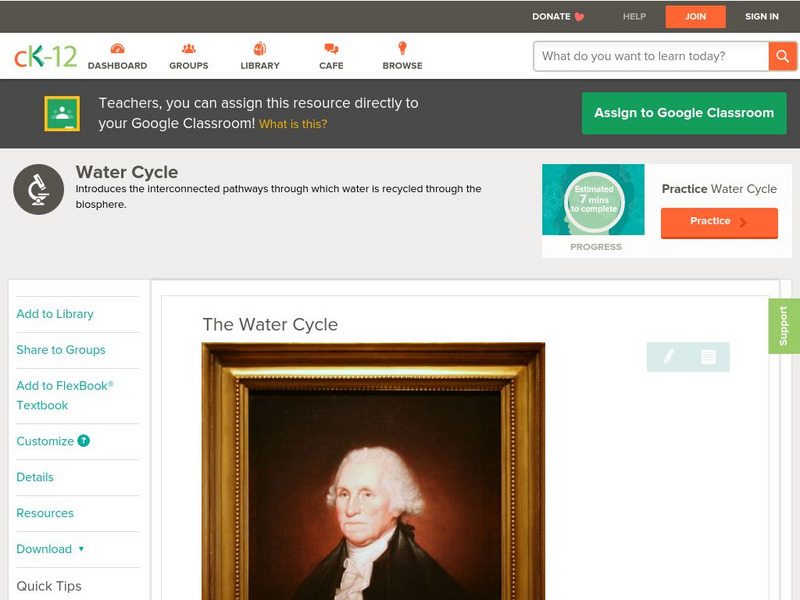Hi, what do you want to do?
Utah Education Network
Uen: Living or Nonliving
Third graders look for living and nonliving elements on the playground.
Utah Education Network
Uen: Living and Nonliving
Third graders will be able to identify what is living and nonliving in the world around them.
Utah Education Network
Uen: Are You Among the Living or the Nonliving?
Great site to test your knowledge on living and nonliving things. Play a game that tests your knowledge, and view pictures to pick out each living organism.
E-learning for Kids
E Learning for Kids: Science: Marshall Islands: How Can We Tell Living Things From Non Living Things?
Andrea lives on the Marshall Islands, and she will teach you about living and nonliving things.
E-learning for Kids
E Learning for Kids: Science: Scotland: How Can We Group Non Living Things Based on Characteristics/purposes?
Montgomery is a true Scot, and even wears a kilt. He works in his dad's store and needs help learning about materials.
BiologyWise
Biology Wise: Comparison of Living and Non Living Things
Compares the characteristics of living and non-living things based on respiration, life processes, response to stimuli, death, and composition.
ArtsNow
Arts Now Learning: Dramatic Living and Non Living [Pdf]
Students explore the differences between living and nonliving things through the lens of the nursery rhyme, "Hey Diddle Diddle." After bringing the characters to life, the students discuss the concepts of living and nonliving and act out...
Other
Vida: Living and Non Living Things
Study these four images when learning about living and nonliving things.
Utah Education Network
Uen: Looking at the Community Tree
A neighborhood tree is observed for evidence of interactions between living and nonliving things.
Utah Education Network
Uen: Trb 3:2 Investigation 3 Terrariums / Aquariums
Creating aquariums/terrariums help students understand how creatures depend on living and nonliving things.
Utah Education Network
Uen: Mini Ecosystems
Third graders will make small-scale environments and will describe interactions between living and nonliving things in their environments.
Utah Education Network
Uen: What It Is, What It Isn't
Recognize characteristics of living and nonliving items within an environment.
Utah Education Network
Uen: What's Different About These Worms?
Observe three different worm models and identify characteristics.
SMART Technologies
Smart: Living and Nonliving Things
Students define the characteristics of living and non-living things, identify living and non-living components of an ecosystem, and identify the roles of organisms in living systems.
Science Education Resource Center at Carleton College
Serc: Looking for Living and Nonliving Things
Students will think about what is alive and identify the objects they observe as living or nonliving. They will record their findings in a journal, share them with their classmates, then illustrate a page for a class book of things they...
Alabama Learning Exchange
Alex: Wanted Dead or Alive!
In this lesson students will identify the characteristics of living and nonliving things.
CK-12 Foundation
Ck 12: Life Science: Ecosystems
[Free Registration/Login may be required to access all resource tools.] Ecology is the study of ecosystems. That is, ecology is the study of how living organisms interact with each other and with the nonliving part of their environment....
ClassFlow
Class Flow: Living and Nonliving
[Free Registration/Login Required] Flipchart details characteristics of living and nonliving things, then asks students to classify. Activote questions are included.
Georgia Department of Education
Ga Virtual Learning: Ap Biology: Ecology
Students review the study of living things and make connections back to Earth's systems. This unit focuses on how various species, grouped in populations and communities, work with the nonliving things around them to ensure survival.
OpenSciEd
Open Sci Ed: 7.4 Matter Cycling & Photosynthesis
Where does food come from and where does it go next? This unit helps students figure out that they can trace all food back to plants, including processed and synthetic food. They obtain and communicate information to explain how matter...
Other
Hub Pages: Abiotic Factors: A Component of Ecosystem
In the environment, there are external factors that really affect organisms living within it. One of these factors is the set of abiotic factors, or nonliving variables, such as wind, ocean, day length, rainfall, temperature, and ocean...
PBS
Nh Pbs: Nature Works: Ecosystems
How would you define an ecosystem? Check out this educational resource to learn more about the living and nonliving parts of different ecosystems.
CK-12 Foundation
Ck 12: Life Science: Water Cycle
[Free Registration/Login may be required to access all resource tools.] Water and elements like carbon and nitrogen are constantly being recycled through the environment. This process is called a biogeochemical cycle because it involves...
University Corporation for Atmospheric Research
Ucar: Biogeochemical Cycles
The ways in which an element or compound such as water moves between its various living and nonliving forms and locations in the biosphere is called a biogeochemical cycle. All of the atoms that are building blocks of living things are a...

















